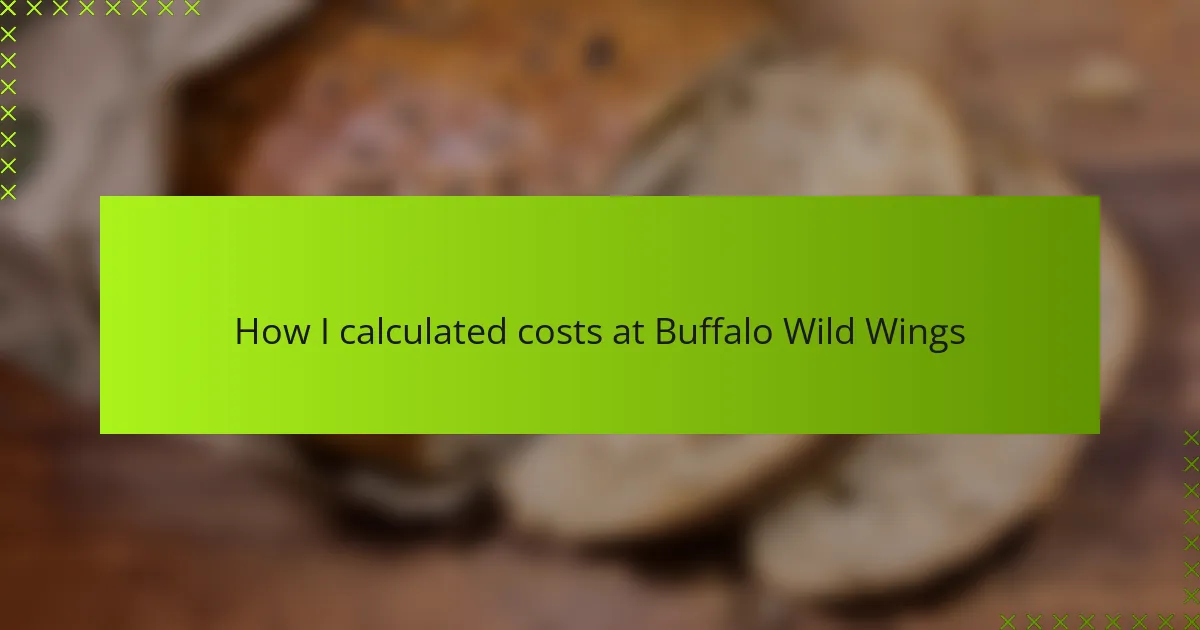Key takeaways
- Understanding restaurant cost calculation involves food, labor, overhead costs, and markup strategies to set menu prices.
- Promotions and happy hour specials can significantly influence overall spending, allowing for budget-friendly dining experiences.
- Utilizing tools like online calculators and spending tracking apps can help diners better understand their costs and enhance their dining choices.
- Breaking down costs for menu items, including tips and taxes, enables diners to enjoy meals without financial stress or confusion.
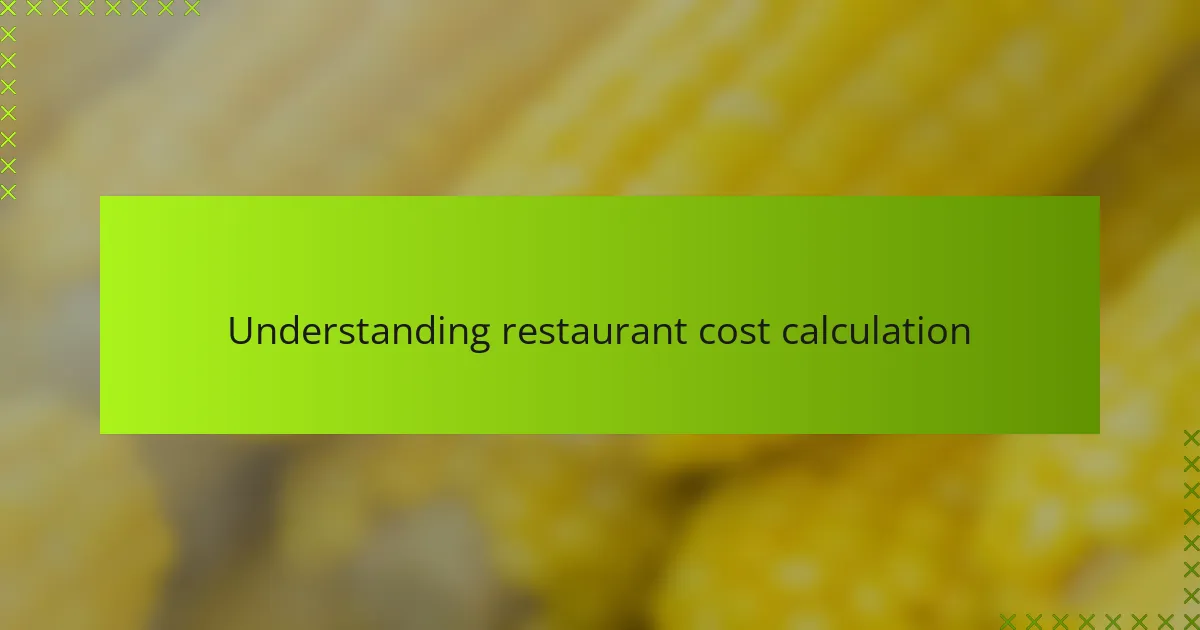
Understanding restaurant cost calculation
When it comes to understanding restaurant cost calculation, there’s more to it than just looking at the menu prices. I remember my first visit to Buffalo Wild Wings; I was excited about trying their famous wings, but I quickly realized how important it is to grasp the overall costs, including food, labor, and overhead. It’s fascinating how each aspect plays a crucial role in determining the prices we see on the menu.
To break it down further, here are some key factors to consider when calculating costs at a restaurant like Buffalo Wild Wings:
- Food Costs: This includes the price of raw ingredients for each dish served. For example, chicken wings, sauces, and sides can vary in price based on season and supplier.
- Labor Costs: Employee wages, tips, and benefits contribute significantly to the overall expenses. I recall waiting longer for my order once due to a staff shortage, which made me think about the hidden costs within the dining experience.
- Overhead Costs: Rent, utilities, and maintenance add up quickly. It’s easy to overlook how a restaurant’s location can impact these costs, especially in busy areas.
- Markup: Restaurants often use a markup strategy on their menu items, typically ranging from 2.5 to 3 times the food cost, to cover expenses and achieve profit.
- Daily Specials: Promotions can offer value to diners while also managing inventory – I once snagged a great deal on wings during a happy hour, perfectly illustrating how cost calculation works.
These elements paint a vivid picture of what it takes to run a successful restaurant, and understanding them elevates the dining experience for all of us.
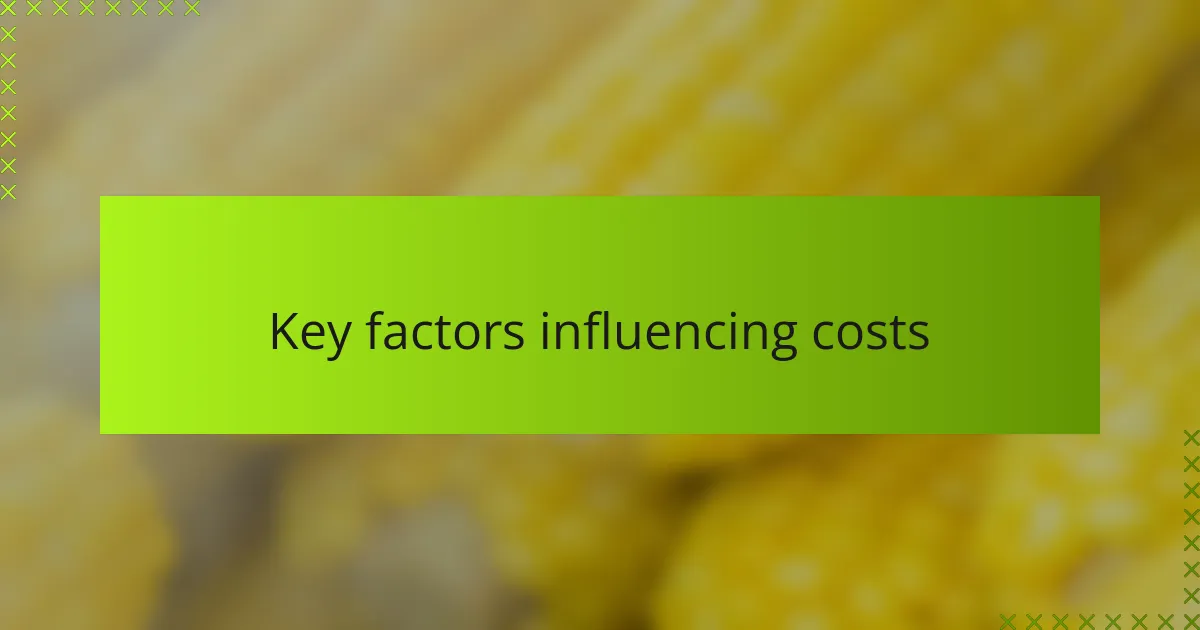
Key factors influencing costs
When calculating costs at Buffalo Wild Wings, several key factors come into play. First, menu pricing varies based on location and time of day, which can greatly influence overall spending. I remember noticing that during happy hour, the wings were significantly cheaper, which made for a fun evening out with friends without breaking the bank.
Additionally, special deals and promotions can impact costs. For instance, I often find that certain days offer discounts on specific items, allowing me to enjoy a variety of flavors without feeling guilty about my budget. It’s fascinating how strategic promotions can make a major difference in the final bill.
Here’s a comparison table to illustrate how these factors can influence costs:
| Factor | Impact on Costs |
|---|---|
| Menu Pricing | Varies by location; different items have different prices |
| Happy Hour Specials | Lower prices during specific hours can save money |
| Promotions | Days with discounts allow for more variety and lower bills |
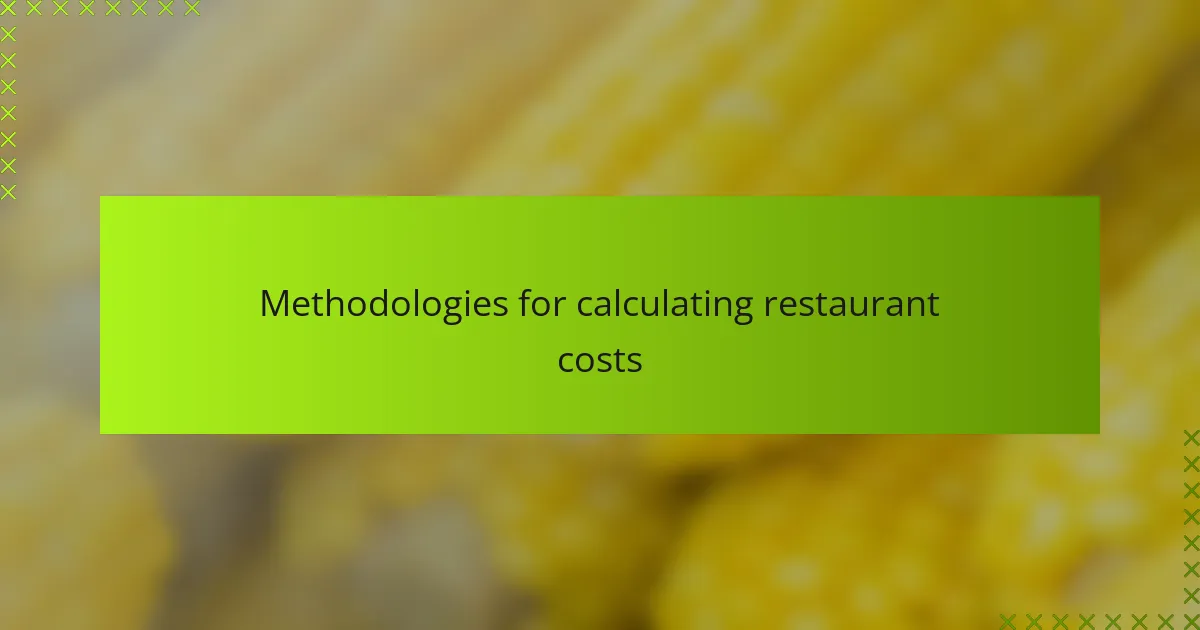
Methodologies for calculating restaurant costs
When I set out to calculate costs at Buffalo Wild Wings, I used a few different methodologies that helped in understanding the pricing structure. One approach was to analyze the menu prices against my usual order habits; this gave me insight into how much I tend to spend during a visit. I also compared the prices to similar establishments in the area, allowing me to see if Buffalo Wild Wings offered good value for the experience and food quality they provide.
Another effective method I found was to look at portion sizes relative to the cost. I recall realizing that while certain appetizers seemed pricey, the quantity often justified the expense, especially when sharing with friends. This added an emotional layer to my decision-making, understanding that dining out is not just about the dollars spent, but also about the connections made over a shared meal.
Here’s a table summarizing the methodologies I used for calculating costs:
| Methodology | Description |
|---|---|
| Menu Price Analysis | Comparing individual order habits to menu items. |
| Market Comparison | Evaluating Buffalo Wild Wings prices against similar restaurants. |
| Portion Size Review | Assessing portion sizes to determine value for the price. |
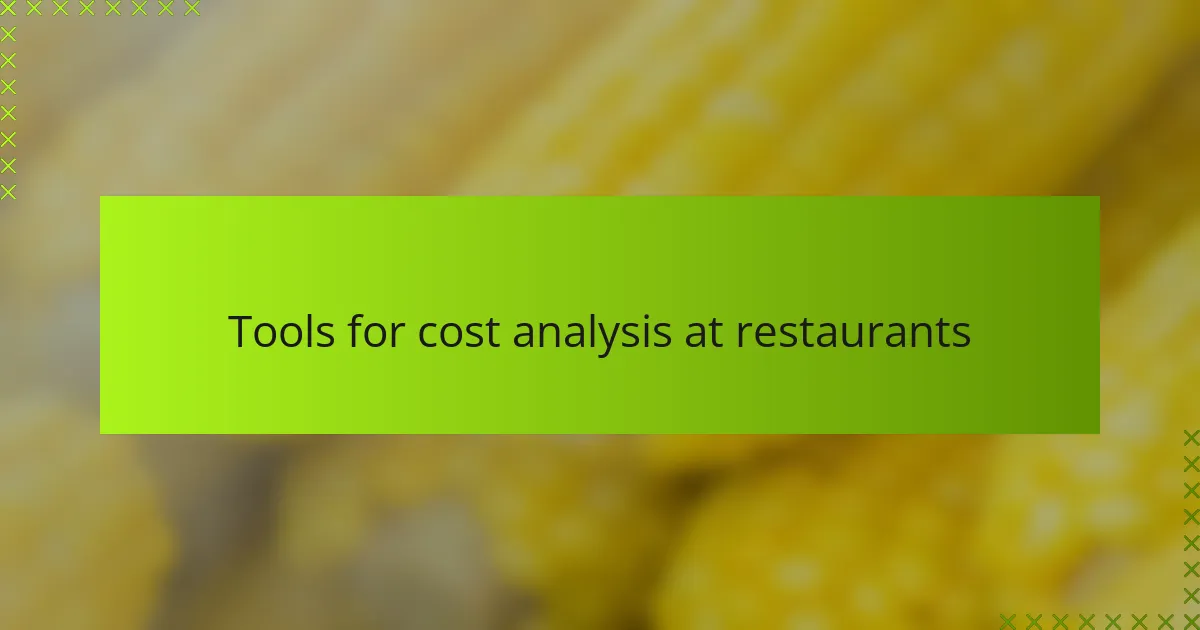
Tools for cost analysis at restaurants
When analyzing costs at restaurants, data tools can be incredibly useful. I remember using online calculators to estimate meal costs based on menu items while factoring in local sales tax and tips. It provided a clear picture of what my final bill would look like, helping me plan my budget for the outing.
Another approach involves utilizing apps that track restaurant spending over time. These apps can generate reports showing my average expenditure per visit. I found this particularly enlightening—it prompted me to question whether I was getting enough value for my spend at Buffalo Wild Wings. Sometimes, seeing the numbers laid out can trigger a change in habits, like opting for that happy hour special instead of full-price wings.
Lastly, inventory management tools are essential for restaurants, and they can also shed light on cost efficiency. For instance, I learned that seasonal ingredients often affect menu prices. When I ordered their spring specials, it struck me how the freshness not only elevated the flavor but also felt more aligned with the cost structure of the restaurant. Understanding how these tools function offers insights not just for the restaurant owners but also for diners like me, enhancing the overall experience.
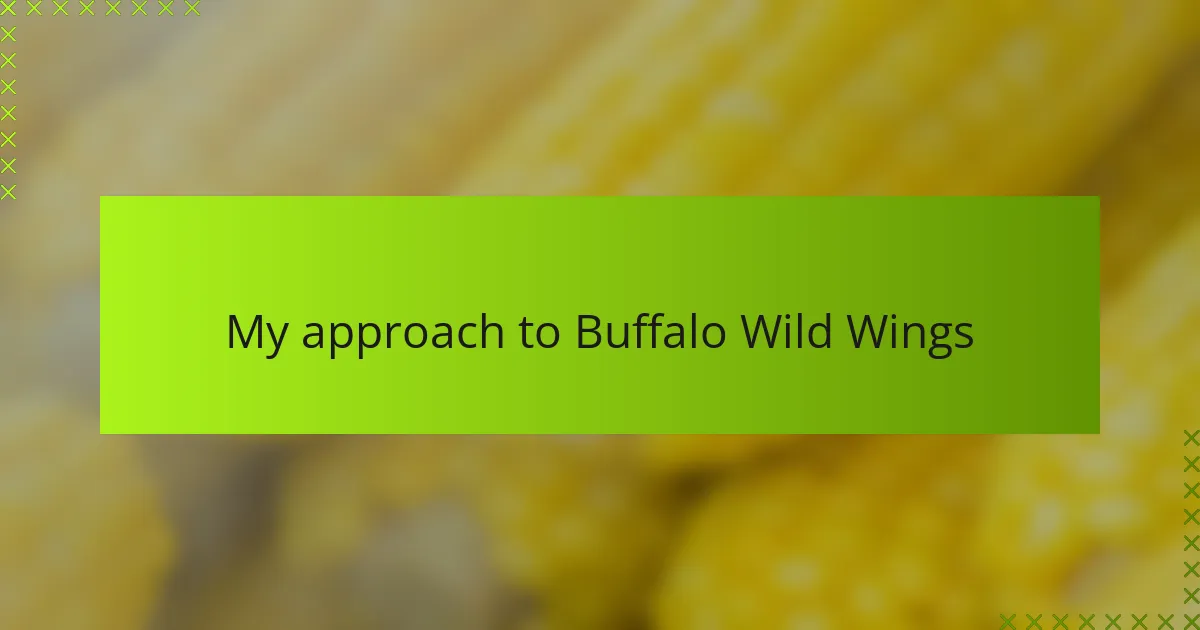
My approach to Buffalo Wild Wings
When I first approached Buffalo Wild Wings, I had to consider all the cost factors involved. It wasn’t just about the price on the menu; I wanted to factor in things like tips, taxes, and potential extras like appetizers or drinks. I found that by planning my meal ahead, I could enjoy everything the restaurant had to offer without overspending.
I remember my first visit; I was excited but nervous about ordering more than I could afford. After examining my choices closely, I discovered that some combo deals offered great value, which helped me manage my budget better. By breaking down the costs into manageable parts, I was able to savor the experience without the stress of financial worry.
Here’s how my calculations lined up against the typical menu options at Buffalo Wild Wings:
| Item | Estimated Cost |
|---|---|
| Wings (10-count) | $10.99 |
| Appetizer (Nachos) | $8.49 |
| Drink (Beer) | $5.00 |
| Tax (8%) | $2.09 |
| Tip (15%) | $3.00 |
| Total Estimated Cost | $29.57 |
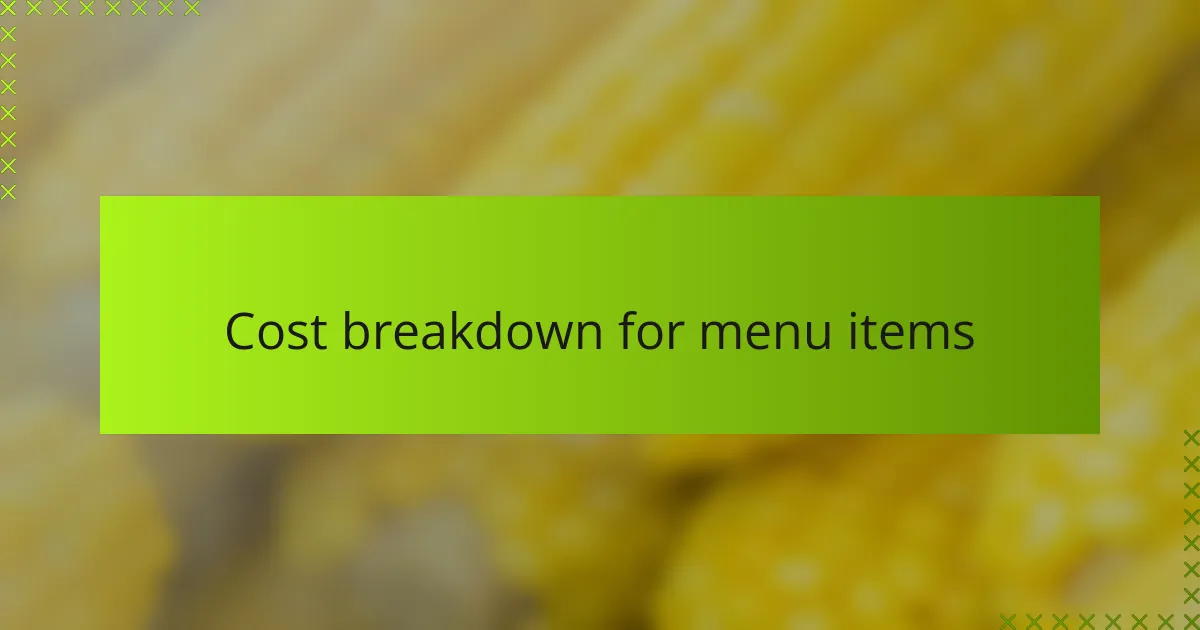
Cost breakdown for menu items
When I look at the menu at Buffalo Wild Wings, I can’t help but consider the actual cost breakdown of what I’m ordering. For instance, when I opted for a 10-count wings order priced at $10.99, it immediately made me wonder about the raw material costs and how those play into what I ultimately pay. It’s crucial to recognize that just because something is priced at $8.49 for nachos doesn’t mean that it equates to what the restaurant pays for those ingredients. That gap is what keeps the lights on and staff smiling.
While enjoying a beer that costs around $5.00, I often think about how the markup on drinks can significantly contribute to a restaurant’s profit margin. Have you ever noticed how ordering a drink can sometimes feel like a big part of the overall experience? I find that while I savor my beer, I’m also inadvertently supporting the restaurant’s ability to run smoothly, which makes me feel good about my choice.
Moreover, seeing the total estimated cost breakdown helps me grasp the bigger picture. When I calculated everything—wings, appetizers, drinks, tax, and tip—it really opened my eyes to how seemingly small decisions can add up. Have you ever felt a bit of sticker shock at the end of a meal? By mentally running through the costs, I found that I could enjoy my meal guilt-free, knowing exactly what I was spending and how each item contributed to the overall dining experience.
